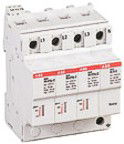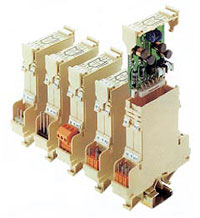A surge arrestor (surge suppressor) is a device that protects electrical devices and systems from voltage spikes. The devices regulate the voltage supplied to electric device and/or systems by shorting to earth voltages above a safe threshold, or by blocking. Surge protection devices are known collectively by the abbreviation SPDs. This article is about surge suppression using SPDs. Voltimum managing editor James Hunt has a look at the topic here:

Voltage spikes or surges are fast, short duration electrical transients in an electrical circuit. Fast, short duration electrical transients (overvoltages) in the electrical potential of a circuit are typically caused by lightning strikes, tripped circuit breakers, short circuits, the switching off of lighting and the starting and stopping of AC motors, power outages, power transitions in other equipment on the same power line, malfunctions caused by the power utility, storm-damaged powerlines, and electromagnetic pulses in the 100kHz - 1MHz frequency range. Up to 80% of such transients are generated from internal sources such as inductive load switching and normal equipment operations, while at least 20% of transients are generated from external sources such as lightning and power utility switching.
The overall result can be cumulative equipment damage and possible premature failure, expensive system resets and down time and data losses. It can even result, especially from lightning strike, in catastrophic equipment failure resulting in immediate shutdown, as well as longer term disruption of businesses, plus expensive equipment repair and replacement costs.
Prevention and important parameters:
The prevention of such potential damage is through use of surge arrestors. For example, a transient voltage surge suppressor protects against transient voltage spikes that occur in less than 0.000000001s.
Important parameters that affect the design - and also the choice - of surge arrestor, include the let-through voltage. This specifies the voltage that will cause an arrestor to conduct electricity to the earth line. A lower let-through voltage should provide greater protection, but with a shorter surge arrestor life.
Another important parameter is the energy that it can absorb without failure. The greater the energy, the greater the protection, and also the longer the life expectancy. This is because the device will divert more energy elsewhere and will absorb less of it. The greater the energy conducting the same surge current, the lower the let-through voltage.
The response time is yet another important parameter to be considered. This is because surge arrestors don't work immediately - there is always a very slight delay. This is an important factor because the longer the response time, the longer the connected equipment will be exposed to the surge. Luckily, since voltage spikes and surges also take time to evolve, surge arrestors usually have enough time to suppress the most damaging part of the spike/surge concerned.
Lightning strike can cause very large overvoltages. Peak currents are also high, typically ranging from around 2000 - 400,000A. Some surge arrestors designed to protect three-phase systems against lightning strike are said to be able to pass currents of 320,000A/phase (equivalent to 1,200,000A total). Suitable surge arrestors must be energy co-ordinated so that the total loading of the protective devices is subdivided according to their power carrying capability. This is to ensure that the lightning voltages etc will be reduced to levels below the immunity of devices to be protected.
Surge arrestor component types:
Metal oxide varistor (MOV) - This, the most common protector component in AC power arrestors, contains a current-conducting material (typically granular zinc oxide) that conducts current when a voltage above rated voltage occurs - such as a spike. MOVs typically limit voltages to about three to four times the normal circuit voltage by diverting the surge current elsewhere. MOVs have the disadvantage of being degraded when subjected to several large transients - or a greater number of smaller transients. To overcome this problem, MOVs can be connected in parallel to increase current capability and life expectancy; however, they must be arranged in matched sets.
Transient suppression diode - This is a type of zener diode that limits voltage spikes - usually to less than twice the normal operational voltage. It is also sometimes termed an avalanche diode or suppression diode. Transient suppression diodes are claimed to provide the most suitable limiting action of protective components for many applications, but have a lower current capability. Note that as long as current variations stay within device ratings, transient suppression diode life expectancy is very long, but if ratings are exceeded, the diode may fail as a short circuit. Because of their relatively limited current capacity, transient suppression diodes are usually used with circuits likely to be exposed to smaller current spikes, and where such spikes are likely to occur more often. Note that bi-polar operation is possible using a transient diode containing reversed paired avalanche diodes.
Gas discharge tube (GDT) - This type relies on a gas trapped between two electrodes that is ionised by the high voltage to conduct electrical current. GDTs can conduct more current for their size than other components. Like MOVs, they have a finite life expectancy, and can accept a few very large transients or a greater number of smaller transients. The type also takes time to trigger, so that a higher voltage spike can exist before the arrestor conducts significant current. Therefore, it is sometimes necessary for extra protection to be provided to prevent damage because of the longer trigger time. GDTs find most applications in telecommunications equipment and in HF lines.
Selenium voltage suppressor - This type is, in some ways, similar to a MOV but is less effective in terms of let-through voltage, yet has a longer life. The type can dissipate power continuously and retains its voltage let-through characteristics throughout the surge event. Selenium voltage suppressors are mainly used in high-energy DC circuits, such as an alternator exciter field.
Quarter-wave coaxial surge arrestor - This type features a tuned quarter-wavelength short-circuit stub that allows the arrestor pass a bandwidth of frequencies - while presenting a short to any other signals, especially down towards DC. The bandwidths can be narrow or wideband. This type of surge arrestor provide, it is said, the best and most reliable protection for RF signals above 400MHz, so it tends to be used in RF signal transmission routes.
Combined lightning current / surge arrestor - This is necessary in terms of the energy co-ordination requirement between the various surge arrestor devices and the devices to be protected. The combined lightning current / surge arrestor is the result, and it features a high discharge capacity for lightning currents (accommodating the waveform necessary for lightning equipotential bonding), and a voltage protection level of below 1.5kV for safe insulation co-ordination with terminal devices and the electrical installation operating equipment. A combined arrestor also provides energy co-ordination with downstream surge protection devices in the installation and with the consumers to be protected.
Surge arrestor standards:
There are a number of standards that relate to surge arrestors. The following are some of the most important:
IEC 61643-1 - Low-voltage surge protective devices - Part 1: Surge protective devices connected to low-voltage power distribution systems - Requirements and tests.
EN 61643-11 and 21 specify surge arrestor products' performance and safety requirements. BS EN 61643-11:2002 - 'Low voltage surge protective devices. Surge protective devices connected to low-voltage power systems. Requirements and tests'. BS EN 61643-21:2001 - 'Low voltage surge protective devices. Surge protective devices connected to telecommunications and signalling networks. Performance requirements and testing methods'. According to EN 61643-11, LV surge protection devices are classified as Types 1, 2, and 3 - but this has lead to some confusion in the past, with a multiplicity of arrangements.
EN 62 305 - This is the standard for lightning protection (now adopted in the UK as BS EN 62 305). It requires that co-ordinated surge protective devices are installed at the entry of the LV supply system, and it describes precisely the use of surge protective devices for internal lightning protection. It also specifies that the lightning protection zone concept requires the installation of surge protective devices whenever an electrical conductor crosses the boundary between two lightning protection zones.
IEC 60099-4 Ed. 2.1 - This became mandatory in July 2006, defining new rules for short-circuit tests of arrestors. Part 4 applies to non-linear MOV type surge arresters without spark gaps designed to limit voltage surges on AC power circuits. The latest version of IEC 60099-4 includes a new classification of arrestor designs depending on their internal construction. There are other parts of IEC 60099. Part 5, for example, provides recommendations for the selection and application of surge arrestors to be used in three-phase systems with nominal voltages above 1kV. It applies to non-linear resistor type gapped surge arresters as defined in IEC 60099-1 and to gapless metal-oxide surge arresters as defined in IEC 60099-4.
UL 1449 - This covers SPDs designed for repeated limiting of transient voltage surges as specified in the standard on 50 or 60Hz power circuits not exceeding 1000V.
